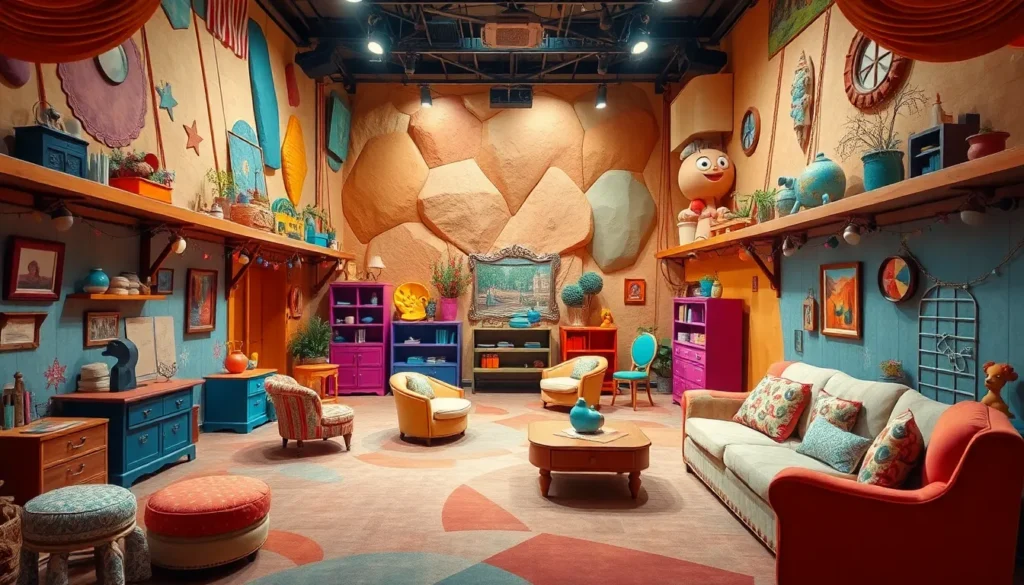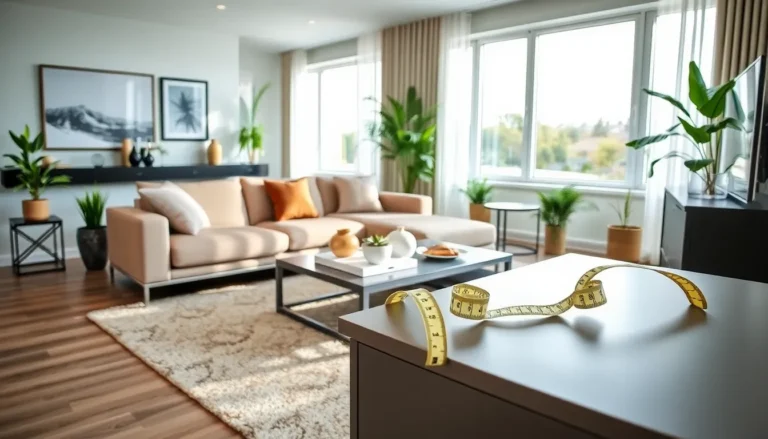Table of Contents
ToggleSet design is more than just pretty backdrops and fancy props; it’s the unsung hero of storytelling. Imagine a world where every scene is a blank canvas waiting to be transformed into a visual feast. That’s where set designers come in, wielding their creativity like a magic wand to create immersive environments that transport audiences into the heart of the action.
Analyzing set design reveals the hidden layers of meaning and emotion that can make or break a production. From the subtle color choices to the strategic placement of furniture, every detail plays a crucial role in shaping the narrative. So, buckle up as we dive into the fascinating world of set design analysis, where art meets storytelling, and where every corner holds a secret just waiting to be uncovered.
What Is Set Design Analysis?
Set design analysis involves examining the components of a set to understand its role in supporting the narrative. Designers create environments that communicate themes and emotions, drawing audiences into the story. This analysis focuses on elements such as spatial arrangement, color schemes, and texture choices, which shape viewer perception and experience.
One aspect of set design analysis includes evaluating how space influences character interactions. For instance, an open space might suggest freedom, while a confined set may create tension. Analyzing these spatial elements leads to deeper insights into character motivations and relationships.
Color choices within a set carry significant meaning. Warm colors like red and orange often evoke feelings of passion or warmth, while cool colors like blue and green can inspire calmness or sadness. Designers consider these emotional responses when selecting palettes, reinforcing the storyline’s tone.
Texture also plays a crucial role in set design analysis. Smooth surfaces might symbolize modernity and cleanliness, whereas rough textures can indicate neglect or chaos. Each texture selection can enhance the audience’s understanding of the setting and its symbolism.
By studying these components, one recognizes that set design is integral to effective storytelling. It establishes atmosphere and enhances narrative depth. Each detail, from furniture arrangement to color selection, works together to create an engaging visual narrative. Through thorough set design analysis, the connection between visual elements and narrative significance becomes clear, enriching the overall production experience.
Importance Of Set Design Analysis

Set design analysis plays a crucial role in understanding how a production communicates its narrative. It emphasizes the interaction between visual elements and storytelling.
Enhancing Storytelling
Set design enriches storytelling by creating immersive worlds. Elements like color and texture shape the emotional landscape. Lighting and spatial arrangements guide viewer focus, directing attention to key moments or characters. Each detail, from props to furniture placement, enhances the narrative tone. A vibrant environment can evoke joy, while a dark, chaotic set intensifies tension.
Influencing Audience Perception
Audience perception hinges on effective set design choices. The arrangement of space affects how viewers interpret character relationships. Open spaces suggest a sense of freedom, while confined areas can imply conflict. Color choices also significantly impact emotions. Warm hues like red inspire passion, whereas cool tones such as blue promote calmness. Texture adds another layer, as sleek surfaces convey modernity and rougher materials evoke disorder. This multifaceted approach ensures that set design deepens the audience’s experience, making it integral to overall storytelling.
Elements Of Set Design
Set design comprises various elements that contribute to the storytelling experience. Understanding these components enhances appreciation for a production’s visual narrative.
Color Scheme
Color schemes play a pivotal role in influencing emotions and perceptions. Warm colors, like red and orange, can evoke feelings of passion and excitement. Cool colors, such as blue and green, often instill calmness and tranquility. These hues impact audience moods significantly. They help set the tone of a scene, guiding viewer interpretations of character dynamics. Complementary colors create harmony, while contrasting colors can introduce tension. Effective use of color unifies set elements, establishing the overall atmosphere. Choices around saturation and brightness further deepen emotional responses, establishing connections between the audience and narrative.
Spatial Arrangement
Spatial arrangement organizes elements within a set to reflect relationships and dynamics between characters. Open spaces may suggest freedom or possibility, inviting movement and interaction. Conversely, tight configurations can create feelings of confinement or tension, impacting character behavior. Designers use depth and layers to draw focus to specific areas or actions within a scene. The arrangement of furniture, props, and pathways affects how characters traverse the space. Each choice influences how audiences perceive character motivations and emotional states. Close positioning can enhance intimacy, while distant placements foster isolation, enriching the storytelling experience.
Textures And Materials
Textures and materials add depth and dimension to a set design. The choice between smooth and rough surfaces creates distinct atmospheres. For instance, polished finishes often symbolize modernity or sophistication, while rough textures suggest chaos or decay. Materials such as wood, metal, or fabric each convey different meanings through their tactile qualities. Set designers often mix textures to generate visual interest and emphasize contrasts. This interplay can enhance emotional resonance, allowing viewers to connect more deeply with the narrative. Varied textures help delineate spaces, guiding audience focus to essential actions and interactions.
Case Studies In Set Design Analysis
Case studies provide valuable insights into the impact of set design on storytelling. They illustrate how spatial arrangements, colors, and textures create immersive experiences.
Film Example
In “The Grand Budapest Hotel,” set designer Adam Stockhausen crafted distinct environments that reflect the film’s whimsical nature. Using vibrant colors like pinks and purples, he evoked nostalgia and charm. Each room’s spatial arrangement revealed character dynamics; open areas suggested freedom while narrow hallways enhanced tension. Textured surfaces also played a vital role; soft fabrics contrasted with harsh elements, embodying the film’s themes of elegance and decay.
Theatre Example
In the theatrical production of “The Glass Menagerie,” set designer David Zinn used minimalistic design to enhance emotional depth. The fragmented space mirrored the characters’ complex relationships. Color schemes featured soft pastels, instilling a sense of nostalgia and fragility. The texture of the set—smooth surfaces contrasted with rough, worn elements—reinforced the themes of memory and loss. Each design choice deeply connected with character emotions, guiding the audience’s understanding throughout the performance.
Set design analysis reveals the profound connection between visual elements and narrative depth. By dissecting components like color, texture, and spatial arrangement, one uncovers how these choices shape audience perception and emotional response. Each element contributes to a richer storytelling experience that resonates on multiple levels.
The case studies highlighted demonstrate the transformative power of set design in both film and theater. They show how thoughtful design choices can elevate a narrative, making it more engaging and impactful. Understanding set design is essential for anyone interested in the art of storytelling, as it plays a crucial role in crafting immersive worlds that captivate viewers.







